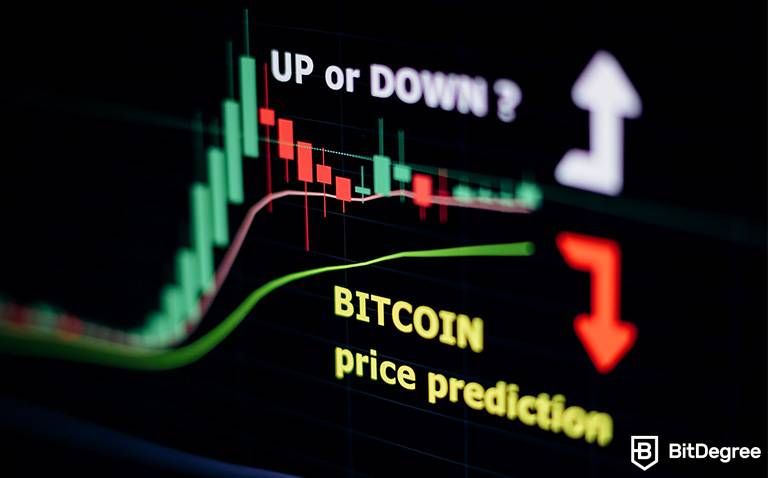Free Airdrop Season 7 is LIVE! Answer fun questions or do simple tasks to earn rewards from the $30K BitDegree prize pool. Participate Now ! 🔥
Starting your crypto trading venture can feel confusing and overwhelming at first, especially if you haven’t been involved in traditional trading before either. Today, we’ll alleviate some of these difficulties and answer a very simple yet vital question – what is spot trading in crypto?
Spoiler alert: this concept is quite simple to get the hang of, and what matters most is to learn to tell spot trading apart from other market terms, like margin or derivatives. We’ll take a look at the similarities and differences between these terms. We won’t be able to cover every single related term, but you can find them in our Crypto 101 Handbook.
Finally, we’ll see how crypto spot trading looks in practice. If you’re interested in how to trade crypto, we have a more detailed guide here. However, we’ll learn more about some of the tools and settings you’ll be playing around with on the Binance cryptocurrency exchange while learning to trade.
Without further ado, let’s learn more about what is spot trading in crypto.

Did you know?
Subscribe - We publish new crypto explainer videos every week!
What is IOTA's Tangle? IOTA & mIOTA Animated Explainer


Table of Contents
What is Spot Trading in Crypto?
Our first order of business is to define once and for all what is spot trading in crypto. If you have any experience with traditional finance and call yourself a day trader, you won't find the term unfamiliar. In fact, it might be one of the easiest market concepts to understand.
Latest Deal Active Right Now:Head to BitDegree Missions, gather as many Bits as possible & claim your stake of the $30,000 Prize Pool! Don't waste your time & start collecting Bits by completing Missions and referring friends.
Put simply, spot trading is a process where one asset is traded for another at its immediate price point. These transactions are done on the spot, hence their name. It's considered to be one of the most popular means of trading, especially since it encompasses a broad range of assets, including bonds, stocks, and commodities.
The immediate price point at which all assets are bought and sold is known as the spot price. This measure is very dynamic. As you might already know, crypto asset prices tend to be volatile and can change drastically in a matter of seconds. So, the spot price records the exact moment that the trade was initiated.
Here's an example. Let's say that you want to buy USDT tokens and have BTC in your account. You go to the spot market and see that the BTC-USDT rate is around $20,000. So, you set up your market order or find one that's already been placed and buy your desired amount of USDT that's converted at the right price point.
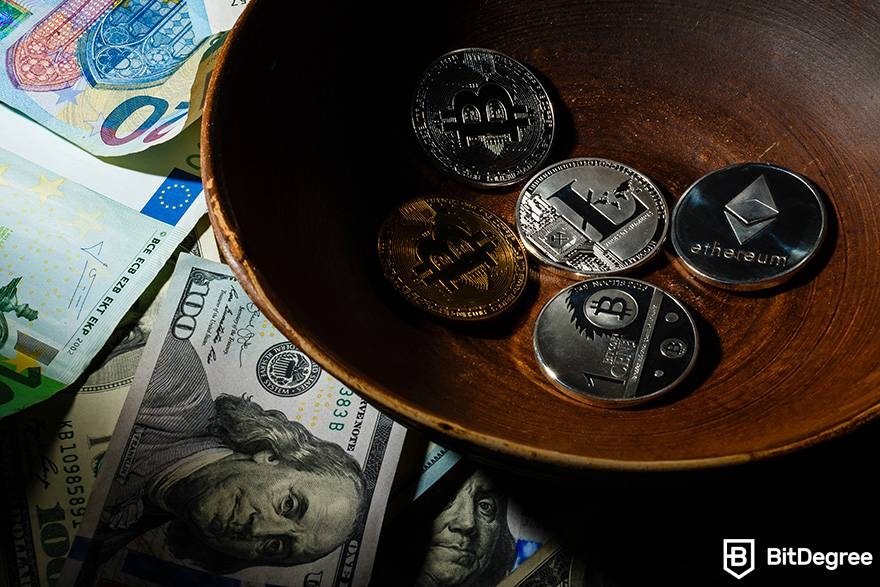
In terms of trade time, you need to know two terms:
- Trade date – it marks the date and time when you initiate the transaction;
- Settlement date – the date and time when the transaction is fully executed. This date may differ from the trade date, as transaction processing can take time due to network congestion.
Of course, there's more that goes into crypto spot trading. If you want to see the process up close, we have a trading guide for you here. However, for now, the key thing you need to know is that spot trading crypto markets offer fast transactions at a momentary rate.
As I mentioned at the start, spot market is a term that comes from traditional finance. However, it has since become an integral part of the crypto landscape. In fact, spot market crypto-related content is more likely to come up than traditional finance if you were to google the term.
Spot markets go hand in hand with centralized cryptocurrency exchanges (CEXs). The majority of CEX platforms on the market are focused on providing spot trading services, in addition to other markets that we will discuss shortly. Typically, if you're spot trading crypto, you will work with crypto-to-crypto transactions.

However, in some cases, the platforms may also offer crypto-to-fiat pairs for traders. However, such platforms must adhere to strict regulations, and the number of available fiat currencies is typically limited. Nevertheless, such features are encompassed in the "what is spot trading in crypto" discussions.
Exchange platforms typically set fees for spot traders. These cover the costs of operation. In many cases, you'll find that the fees are calculated based on the maker-taker model. A market maker is a person that creates a new order at a set price in the order book, while takers accept the order and complete it. Either party can be a buyer or a seller.
Thanks to the role that market makers play in maintaining the platforms' order books, many exchanges reward then with reduced fees or, at a certain level, even grant rebates. Additionally, some exchange pairs, like BTC pairs on Binance, are free from additional fees.
Some exchanges support peer-to-peer (P2P) trading. Instead of creating entries in the order books, traders place bids and select which payment methods they can accept, making it a flexible alternative to trading with an intermediary. However, P2P trading tends to have lower trading volumes, often leading to slower settlements.

If traders need to handle large quantities of cryptocurrency, they may be eligible to use over-the-counter (OTC) services. Such transactions are handled by brokers who set the orders. OTC transactions are generally private and subject to lower fees. Their record may not be logged on-chain after execution, as they are not technically done on the exchange.
So, to answer the question of what is spot trading in crypto, there's a simple description. It's a trading method on a crypto market where transactions are completed using the asset price at the time of setting up the order. It might take a few days for the transaction to process, but it's otherwise considered one of the fastest possible trades.
Now that we've answered the crucial "what is spot trading in crypto" question, let's take a look at what other markets there are for traders.
Spot, Margin, Derivatives, Swaps: Key Differences
Learning what is spot crypto trading like is just one small part of the entire market ecosystem. As you delve deeper and explore centralized exchanges, as well as decentralized ones (DEXs), you'll come across many other market systems and strategies.
So, let's take a look at some of them and see what other trade options there are aside from the spot markets.
Margin Trading
Margin trading is a service offered by many crypto exchanges. However, it's not as widely accessible as spot markets. There are technical reasons for that.
On the surface level, margin and spot trading crypto systems may appear similar. They both offer fast transactions based on current market rates. However, there's one key difference – borrowing and leverage.
Essentially, margin allows you to trade not just your own funds, but borrow additional assets that you need from brokers. While spot trading only uses the assets that you already hold, margin traders can acquire something called leveraged tokens.

These transactions come with thresholds known as margin requirements. Once the requirement is reached, traders receive margin calls that require them to either sell their positions (whether in their entirety or partially) or put more assets that they already own into the account. This is done to maintain equity in a volatile market.
Leverage is a high-risk, high-reward game. If you're trading margin, you'll notice things like x5, x10, or x100. These numbers measure how much your borrowed position can be increased. If your trade goes well, the leverage can make it very profitable. However, if things fall through, you might have to liquidate your assets to pay off the loan.
So, the key difference between what is crypto spot trading and what is margin is the use of leverage through borrowed assets.
Derivatives
In comparison, derivatives markets are where things get a bit more complicated. While not all centralized exchanges offer this service, it's the primary supported trading service on some platforms. First, let's look at the different types of derivatives markets.
There are two derivatives types you'll come across on most platforms:
At first glance, there are several similarities between the two. Both futures and options are contracts between traders. They align what asset the two parties are going to trade, as well as the future trade date and the traded amount.
However, the two differ in how binding they are. A futures contract is an obligation. It means that once you've signed the agreement, you must follow through with its terms and complete the trade at the predetermined date.
Futures contracts are also further split into more categories. On crypto exchanges, the two you'll come across the most frequently are quarterly and perpetual futures. Quarterly futures run on a calendar cycle and expire once the period is over. On the other hand, perpetual futures can be kept indefinitely as they don't have an expiration date.

Options, on the other hand, are non-binding. Either party is able to back out if they change their mind on the agreement or find that the market conditions are not favorable.
Both derivatives markets are considered highly speculatory. They carry a lot of risk, especially when it comes to crypto markets which are notoriously volatile. Although professional traders check market data and make predictions, some unexpected events, like hacks or new popular projects, can suddenly turn things upside down.
Derivatives traders are also able to use leveraged assets. You're not required to own the asset that you want to trade and can rely on leveraged tokens instead. However, this can also increase the risk of the trade.
Therefore, it's typically not recommended for beginners to dive into derivatives markets, and instead to figure out how the crypto spot trading works first. Some platforms offer trading simulators that allow customers to test futures or options strategies without putting their actual assets at risk.
Swaps
So far, we've been discussing trading only on centralized exchanges, as that's what concerns you the most if you're interested in what is spot trading in crypto. However, you've probably already noticed me mention DEXs – decentralized cryptocurrency exchanges.
We won't be delving too deeply into what a DEX is, and if you're curious, you can learn all about the differences between centralized and decentralized trading platforms here. However, what we're concerned with now is how this service works compared to spot trading crypto markets.
When it comes to trading on DEX platforms, you won't really find spot trading in a traditional sense. In fact, many of them will be listing assets that you might not see in the top ranks of a more traditional crypto exchange. Instead, many decentralized platforms focus on swapping tokens.
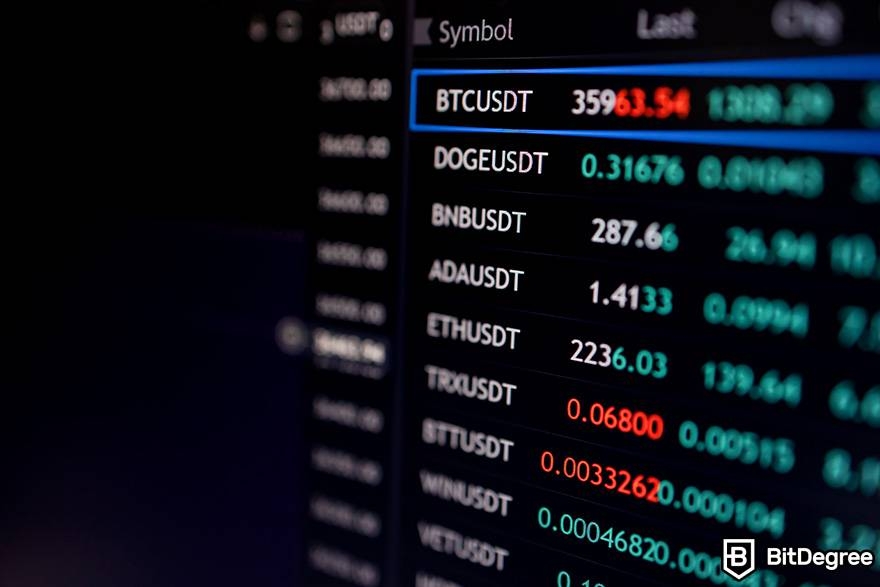
Token swapping is self-explanatory. It's the process of exchanging one token for another between users. Unlike CEX platforms that act as intermediaries between traders, DEXs run exclusively on a peer-to-peer (P2P) model. Some token swaps enable cross-chain token migration, although this can affect transaction fees and speed.
Additionally, decentralized platforms are known for employing automated market makers (AMMs). While CEXs derive their liquidity from custodians, decentralized platforms are, as the name suggests, decentralized – the funds are pooled by users themselves who inject liquidity using their assets.
Automated market makers adjust the liquidity using smart contracts. The use of AMM aims to eliminate the human error factor of traditional order books. Additionally, by contributing liquidity on some of the decentralized exchanges, you may be eligible to earn passive income as a reward.
So, if anyone were to ask you what is spot trading crypto like on decentralized exchanges, know that it's a trick question – the mechanics are not accurate one-to-one, but instead, an alternative trading system altogether that provides similar outcomes.
How Does Spot Trading Crypto Work?
So, that should clear things up on the different market types that you can find once you're venturing into crypto. While answering the "what is spot trading in crypto" question is a great start, it helps to keep the differences of swapping, margin, and derivatives trading in mind as you move along.
In fact, let's have a quick look at some of the pros and cons of spot trading crypto markets compared to the other options:
| PROS | CONS |
| Accurate depictions of market prices | Frequent price fluctuations |
| Faster transaction speed | Less transaction privacy than P2P or OTC |
| More secure than P2P or OTC | May be subject to higher fees than P2P and OTC |
| Less risky than margin trading | Yields lower profits than successful margin trading |
| Easier for beginners than derivatives | Less advantageous than derivatives for professional traders |
| Offers crypto-crypto and crypto-fiat trades | May not list lesser-known tokens |
| Centralized exchanges with spot markets are typically regulated | Centralized crypto spot trading may be regionally restricted |
| Market makers maintain active order books and are rewarded for contributions | Order books may be subject to human error due to the lack of smart contract automation |
Table: The pros and cons of crypto spot trading
However, you’re probably itching to figure out in practice what is spot trading in crypto like. That’s exactly what we’re about to get into. First, of course, we need to figure out which spot market we’ll be looking at. After all, while many centralized exchanges share similarities, there can be just enough differences to miss some interface aspects.
So, to stay consistent, we’ll be taking a look at what is spot trading crypto like on Binance. Binance is known as one of the leading names in the crypto finance field. It’s considered the biggest centralized exchange in the world, and offers a broad range of services. In fact, if you’re interested in margin or derivatives, it’s also a good place to start.
However, if you happen to be from the US, you won’t be able to access the main Binance platform due to regulations. Instead, Binance.US is here to help you out. Don’t worry – the crypto spot trading will be pretty much the same, so you won’t be missing out on anything.
Now, let’s take out first look at the spot market interface on Binance. We won’t be looking at how the actual trading process works but instead explore all the little icons and instruments at hand. We’ll be selecting BTC/USDT as the default trading pair, as bitcoin is the leading cryptocurrency in the world in terms of market capitalization.
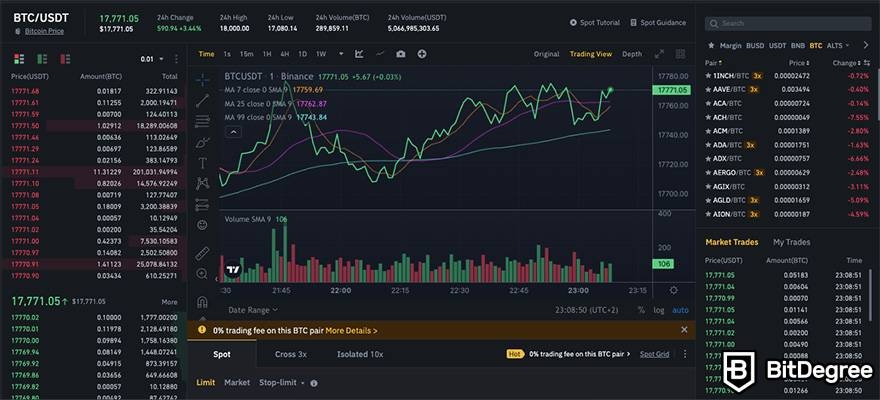
I know – this can look overwhelming at first glance. However, there's no need to worry. We won't be analyzing every single section of the interface. If you need a quick guide, we've covered what each element of the page is and what it does in our How to Trade Crypto guide.
Spot Trading Indicators
We could probably write an article for each section that you can see on the Binance crypto spot trading interface. However, we'll be focusing on one particular section now – Technical Indicators. It's a tiny icon on the whole massive screen, but it plays a crucial role in figuring out not just what is spot trading in crypto, but also how it works.
Binance offers more than 100 different technical indicators, so there's a lot of variety for you to explore. Some of the tools will be helpful even if you're just getting started, while others might be more useful once you have some more experience under your belt.
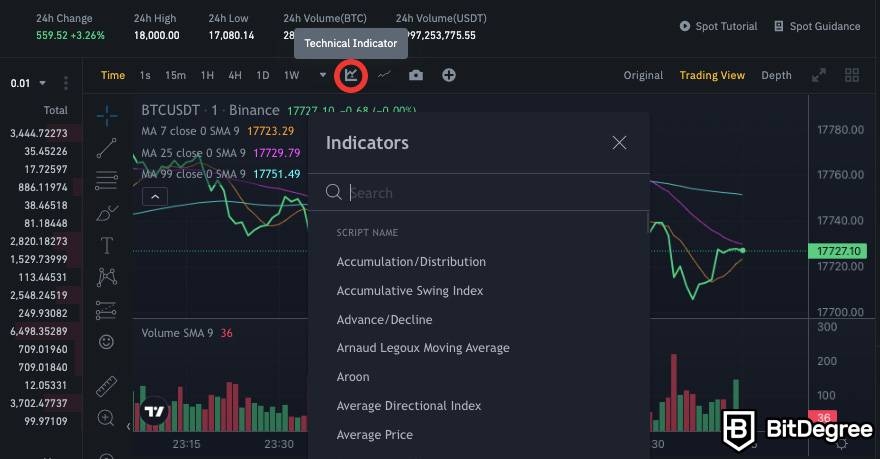
Naturally, we can't cover every single technical indicator available on Binance at once. There's plenty to learn, and going through them all could burn you out or overwhelm you. The "technical" part of technical indicators means that they can get a bit sciency and wordy.
Instead, we'll keep things simple. I've picked out a few technical indicators that you might want to take a look at as part of your "what is spot trading in crypto" education. As for the rest? Well, chances are that we've covered them in our Crypto 101 Handbook.
So, let's have a look:
- Accumulation/Distribution indicator – it's used to establish the current trend of an asset based on the highs and lows of its price in the market during closing times. Accumulation refers to the demand, or the buying stage, while distribution is the supply, or the selling stage;
- Divergence – a technical indicator that describes a market event when the asset's price starts moving in a different direction from other market data – for example, if the trading volume increases but the asset price falls. Divergence can be seen as a sign of an incoming trend reversal. It's part of the MACD indicator;
- Klinger Oscillator – a volume-based indicator that's used to analyze long-term market trends. By comparing the trade volume and the price data from a certain period, the Klinger Oscillator can help determine whether the market is more likely to be bullish or bearish;
- On Balance Volume – this indicator is used to predict the volume flow of an asset. Analysts add up the volume on upper market performance days and subtract it on the lower days. That way, the buy-sell pressure of the asset is determined;
- Relative Strength Index – a technical indicator that is used to calculate the speed of the asset's price changes. It measures the price movements using oscillations on a scale of 1 to 100. RSI shows whether the asset is being overbought or oversold.
As you can see, each technical indicator uses a different measuring method, and each is as important as the other. So, feel free to play around and master the tools for yourself. And before we wrap up, there's just one last thing to quickly cover: trading strategies.

Did you know?
Subscribe - We publish new crypto explainer videos every week!
What is Web3? (Animated Explanation + Examples)



- Secure and reliable
- Accepts fiat currencies
- Lots of trading options
- Reputable exchange
- Accepts fiat currencies
- Offers various trading options

- Fiat currencies - accepted
- Simple to use
- Accepts only the most trustworthy cryptocurrencies
- A leading cryptocurrency exchange platform
- Best for beginner investors
- Accepts fiat currencies

- Fully reserved and transparent
- Multiple tradable asset classes
- Over 300 supported cryptos
- Over 300 cryptocurrencies
- Secure & transparent
- Fully reserved
Spot Trading Strategies
If you're interested in what is spot trading in crypto, you probably have some particular goal in mind. Whether that's making a profit or just testing out the capabilities of the crypto market, you need a strategy to get things right.
If you're wary of taking a blind risk and making the wrong moves, you can try out the Mock Trading tool on Binance. Although it's aimed at futures traders, it can still help you get to know the toolkit at hand better without burning any of your actual assets.
Now, let's talk about your goals while spot trading crypto. Chances are that you're aiming to buy low and sell high. In fact, this is the most frequent agenda among day traders. This will require you to keep a keen eye on the markets and track the price changes to see when the trends shift in your favor.
In that case, you should decide whether you'd rather hold a long or a short position. Shorting is a strategy where you borrow an asset and expect that its price is going to go down. Then, once the price is down to your expectations, you can buy the asset on the spot market and return it to the lender for a lower price than it was going for initially.

Longing, on the other hand, is that buy-low-sell-high strategy we've just talked about. Market experts consider traders that hold long positions to be of a bullish mindset, as they expect that the asset price will increase from the time that they buy it.
Then, you can start thinking about things you can do with the traded assets. There are plenty of uses for different crypto assets, especially as they become more widely accepted as a mainstream payment method.
So, you can just put their purchasing power to use – whether that's paying for your Amazon cart or adding a non-fungible token (NFT) to your crypto wallet.
Then, you can consider investments. If your trading strategy involves longing, you'll be doing some investing by default, as you'll be holding – or HODLing – your assets until you think the time is right to sell. If you want to learn more about what crypto investments entail, you can find our guide here.
So, you can easily start working on a spot trading crypto plan, whether you're preparing to trade or have just wrapped up your first few successful transactions. There's plenty of room to get creative.
Conclusions
We’ve covered quite a lot throughout this article. So, let’s have a quick rundown as we wrap things up. First things first – what is spot trading in crypto?
Put simply, it’s the most straightforward way of exchanging one cryptocurrency for another – or a cryptocurrency for a fiat asset. This method is seen on nearly all centralized cryptocurrency exchanges. For decentralized exchange users, the process of swapping tokens follows similar principles.
If anyone asks you to explain how crypto spot trading differs from other markets, it shouldn’t cause you any trouble. In fact, you'll even be able to list the pros and cons of spot, margin, derivatives, and swapping and have some foundational knowledge once you decide it's time for you to venture into other markets.
Finally, we saw how the spot trading interface works and what tools it provides you with. This knowledge might come in handy when you start trading crypto – and to prepare for this part of your journey, you can find out Binance trading guide here.
Good luck exploring the markets and making a profit while spot trading crypto!
The content published on this website is not aimed to give any kind of financial, investment, trading, or any other form of advice. BitDegree.org does not endorse or suggest you to buy, sell or hold any kind of cryptocurrency. Before making financial investment decisions, do consult your financial advisor.

